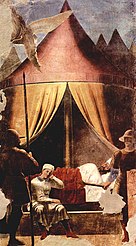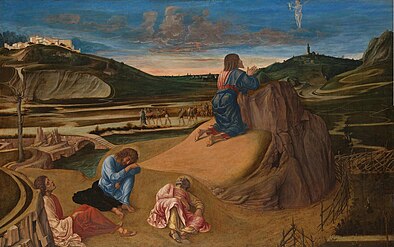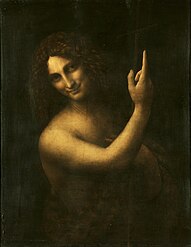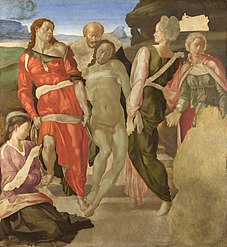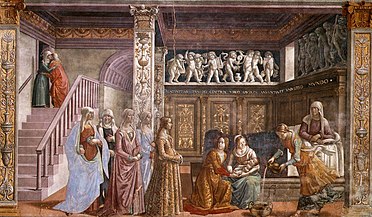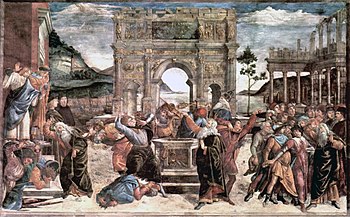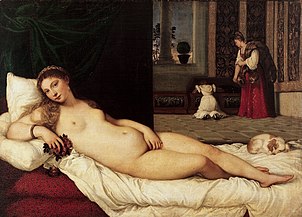Renaissance Art Angel Kneeling With Woman in Green Dress
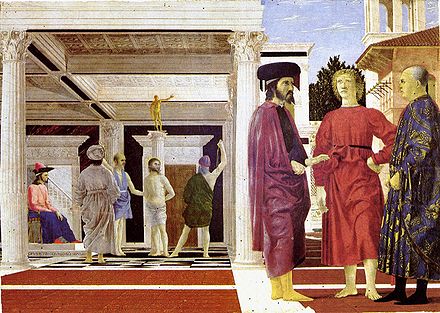
This article near the evolution of themes in Italian Renaissance painting is an extension to the article Italian Renaissance painting, for which it provides additional pictures with commentary. The works encompassed are from Giotto in the early on 14th century to Michelangelo'due south Last Judgement of the 1530s.
The themes that preoccupied painters of the Italian Renaissance were those of both bailiwick matter and execution – what was painted and the style in which it was painted. The artist had far more freedom of both subject and style than did a Medieval painter. Certain characteristic elements of Renaissance painting evolved a nifty deal during the period. These include perspective, both in terms of how it was achieved and the effect to which it was applied, and realism, particularly in the depiction of humanity, either every bit symbolic, portrait or narrative element.
Themes [edit]
The Flagellation of Christ by Piero della Francesca (higher up) demonstrates in a unmarried pocket-sized piece of work many of the themes of Italian Renaissance painting, both in terms of compositional elements and field of study matter. Immediately apparent is Piero's mastery of perspective and light. The architectural elements, including the tiled flooring which becomes more complex around the fundamental action, combine to create ii spaces. The inner space is lit by an unseen calorie-free source to which Jesus looks. Its exact location tin exist pinpointed mathematically past an analysis of the improvidence and the angle of the shadows on the coffered ceiling. The three figures who are standing exterior are lit from a dissimilar angle, from both daylight and light reflected from the pavement and buildings.
The artistic execution of the figures depicted is tied to the painting's immediate historical context. The figure of Pontius Pilate (seated, on the far left) is a portrait of the visiting Emperor of Byzantium.[1] Flagellation is besides called "scourging". The term "scourge" was applied to the plague. Exterior of the hall in which Christ is being flagellated, in the foreground of the painting, stand up three men representing those who buried the trunk of Christ. The two older men, Nicodemus and Joseph of Arimathaea, are believed to exist portraits of acquaintances of Piero della Francesca who had recently lost their sons, one of them to the plague. The third effigy possibly a portrait of one of the sons, or else represent both of them in a single arcadian figure, painted in a similar style to Piero'southward angels in other paintings.[2] The 3rd human being is the young disciple John
Elements of Renaissance painting [edit]
Renaissance painting differed from the painting of the Belatedly Medieval period in its emphasis upon the close ascertainment of nature, especially with regards to human beefcake, and the application of scientific principles to the employ of perspective and lite.
Linear perspective [edit]
Primarily through architecture, Renaissance artists were able to practise the art of three-dimensional illusion using linear perspective, which gave their works a greater sense of depth.[3] The pictures in the gallery below bear witness the evolution of linear perspective in buildings and cityscapes.
- In Giotto's fresco, the building is similar a stage ready with one side open up to the viewer.
- In Paolo Uccello's fresco, the townscape gives an impression of depth.
- Masaccio'southward Holy Trinity was painted with advisedly calculated mathematical proportions, in which he was probably assisted past the architect Brunelleschi.
- Fra Angelico uses the simple motif of a modest loggia accurately drafted to create an intimate space.
- Gentile Bellini has painted a vast space, the Piazza San Marco in Venice, in which the receding figures add to the sense of perspective.
- Leonardo da Vinci did detailed and measured drawings of the groundwork Classical ruins preparatory to commencing the unfinished Admiration of the Magi.
- Domenico Ghirlandaio created an exceptionally complex and expansive setting on three levels, including a steeply descending ramp and a bulging wall. Elements of the landscape, such every bit the church building on the right, are viewed partly through other structures.
- Raphael's design for Burn down in the Borgo shows buildings effectually a small foursquare in which the background events are highlighted by the perspective.
Mural [edit]
The depiction of mural was encouraged by the development of linear perspective and the inclusion of detailed landscapes in the groundwork of many Early Netherlandish paintings of the 15th century. Also through this influence came an sensation of atmospheric perspective and the observation of the way distant things are afflicted by light.
- Giotto uses a few rocks to give the impression of a mount setting.
- Paolo Uccello has created a detailed and surreal setting as a stage for many minor scenes.
- In Carpaccio'south Deposition of the Torso of Christ, the desolate rocky landscape echoes the tragedy of the scene.
- Mantegna's landscape has a sculptural, iii-dimensional quality that is suggestive of a existent physical infinite. The details of the rocks, their strata and fractures, advise that he studied the geological formations of the scarlet limestone prevalent in areas of Northern Italian republic.
- Antonello da Messina sets the grim scene of the Crucifixion in contrast to the placid countryside which rolls into the far distance, becoming paler and bluer equally it recedes.
- Giovanni Bellini has created a detailed landscape with a pastoral scene between the foreground and groundwork mountains. There are numerous levels in this mural, making it the equivalent of Ghirlandaio's circuitous cityscape (above).
- Perugino has set the Adoration of the Magi against the familiar hilly mural of Umbria.
- Leonardo da Vinci, displays a theatrical use of atmospheric perspective in his view of the precipitous mountains effectually Lago di Garda at the foothills of the Alps in Northern Italy.
Lite [edit]
Lite and shade exist in a painting in two forms. Tone is simply the lightness and darkness of areas of a picture, graded from white to black. Tonal arrangement is a very significant characteristic of some paintings. Chiaroscuro is the modelling of apparent surfaces inside a moving picture past the suggestion of calorie-free and shadow. While tone was an of import feature of paintings of the Medieval flow, chiaroscuro was not. Information technology became increasingly important to painters of the 15th century, transforming the depiction of three-dimensional space.
- Taddeo Gaddi'south Annunciation to the Shepherds is the first known big painting of a night scene. The internal light source of the pic is the angel.
- In Fra Angelico'south painting, daylight, which appears to come from the actual window of the friary cell which this fresco adorns, gently illuminates the figures and defines the compages.
- In his Emperor'south Dream, Piero della Francesca takes up the theme of the dark scene illuminated by an affections and applies his scientific knowledge of the diffusion of lite. The tonal pattern thus created is a significant element in the composition of the painting.
- In his Agony in the Garden, Giovanni Bellini uses the fading sunset on a cloudy evening to create an atmosphere of tension and impending tragedy.
- In Domenico Veneziano's formal portrait, the use of chiaroscuro to model the course is slight. Nonetheless, the painting relies strongly on the tonal contrasts of the stake face, mid-tone background and dark garment with patterned bodice for effect.
- Filippino Lippi uses chiaroscuro to model the face of the sitter and define the details of his elementary garment. The calorie-free and shadow on the edge of the window define the angle of the calorie-free.
- The suggested authorship of this early on-16th-century portrait[ clarification needed ] includes Ridolfo del Ghirlandaio, Mariotto Albertinelli and Giuliano Bugiardini. The painting combines many of the lighting effects of the other works in this gallery. The form is modelled by the light and shade, as if by a setting sun, which gives an chemical element of drama, enhanced past the landscape. The tonal pattern created by the night garment, the white linen and position of the mitt is a compositional feature of the painting.
- In Leonardo da Vinci's John the Baptist, elements of the painting, including the corners of the model'due south eyes and mouth, are disguised by shadow, creating an air of ambiguity and mystery.
Anatomy [edit]
While remaining largely dependent upon topographic observation, the knowledge of anatomy was advanced by Leonardo da Vinci'due south meticulous dissection of 30 corpses. Leonardo, amid others, impressed upon students the necessity of the close ascertainment of life and made the cartoon of live models an essential part of a student's formal study of the art of painting.
- Cimabue's Crucifixion, extensively destroyed past overflowing in 1966, shows the formal arrangement, with curving body and drooping head that was prevalent in late Medieval art. The beefcake is strongly stylised to conform with traditional iconic formula.
- Giotto abandoned the traditional formula and painted from observation.
- Massacio's figure of Christ is foreshortened as if viewed from below, and shows the upper torso strained every bit if with the effort of breathing.
- In Giovanni Bellini's Deposition the artist, while not attempting to propose the savage realities of the crucifixion, has attempted to give the impression of death.
- In Piero della Francesca's Baptism, the robust figure of Jesus is painted with a simplicity and lack of sharply defined muscularity that belies its naturalism.
- The figure of Jesus in this painting, which is the combined work of Verrocchio and the young Leonardo, has in all probability been drafted by Verrocchio. The contours retain the somewhat contorted linearity of Gothic art. Much of the torso, all the same, is thought to accept been painted by Leonardo and reveals a strong knowledge of anatomical form.
- Leonardo'south pic of St. Jerome shows the results of detailed study of the shoulder girdle, known from a page of drawings.
- Michelangelo used human anatomy to groovy expressive effect. He was renowned for his power in the creation of expressive poses and was imitated by many other painters and sculptors.
-
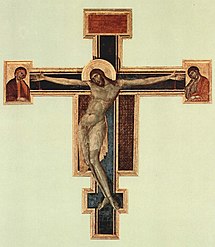
Cimabue. The Crucifix of Santa Croce, 1287
-

Giotto, The Crucifix of Santa Maria Novella, c.1300
-

Masaccio, Crucifixion of Santa Maria del Cherry (Pisa), c. 1420
-
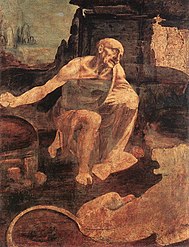
Realism [edit]
The observation of nature meant that set up forms and symbolic gestures which in Medieval art, and particularly the Byzantine way prevalent in much of Italy, were used to convey pregnant, were replaced past the representation of human emotion as displayed by a range of individuals.
- In this Resurrection, Giotto shows the sleeping soldiers with faces subconscious by helmets or foreshortened to emphasise the relaxed posture.
- In dissimilarity, Andrea Castagno has painted a life-sized prototype of the condotierre, Pippo Spano, alert and with his anxiety over the edge of the painted niche which frames him.
- Filippo Lippi in this early work shows a very naturalistic group of children crowding effectually the Virgin Mary, but looking with innocent curiosity at the viewer. One of the children has Down syndrome.
- Masaccio depicts the grief resulting from loss of innocence as Adam and Eve are expelled from the presence of God.
- Antonello da Messina painted several versions of Ecce Homo, the tormented Christ as he was presented to the people by the Roman Governor. Such paintings ordinarily bear witness Christ in a tragic merely heroic role, minimising the depiction of suffering. Antonello'due south depictions are starkly realistic.
- In his Lamentation over the Dead christ, Mantegna has here depicted the dead trunk of Jesus with daring foreshortening, equally if the viewer were standing at the terminate of the slab.
- In this detail from a larger painting, Mantegna shows a little child, wearing a stomach-folder and holey slippers, turning away and chewing its fingers while the baby Christ is circumcised.
- Giorgione paints a natural and unglamorised portrait of an old adult female, unusual in its depiction of her illkempt hair and open up mouth with crooked teeth.
-
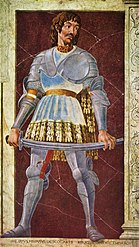
-

-

-

Mantegna, particular from the Circumcision of Christ.
Figure composition [edit]
Amidst the preoccupations of artists commissioned to do big works with multiple figures were how to make the discipline, usually narrative, easily read by the viewer, natural in advent and well equanimous inside the motion picture infinite.
- Giotto combines three separate narrative elements into this dramatic scene gear up against the dehumanising helmets of the guards. Judas betrays Jesus to the soldiers past kissing him. The Loftier Priest signals to a guard to seize him. Peter slices the ear off the loftier priest'southward retainer as he steps forrard to lay easily on Jesus. Five figures dominate the foreground, surrounding Jesus and then that only his head is visible. Yet past skillful arrangement of color and the gestures of the men, Giotto makes the confront of Jesus the focal point of the painting.
- In The Death of Adam, Piero della Francesca has set up the dying patriarch so that he is bandage into relief against the black garment worn by ane of his family. His importance to the story is further emphasised by the arch of figures formed around him and the diagonals of the arms which all atomic number 82 to his head. p
- The Resurrection of the Son of Theophilus is a remarkably cohesive whole, considering that it was begun by Masaccio, left unfinished, vandalised, and eventually completed past Filippino Lippi. Masaccio painted the central section.
- Antonio and Piero del Pollaiuolo, in this highly systemised painting, have taken the cross-bow used by the archers in the foreground, as the compositional construction. Inside this big triangular shape, divided vertically, the figures alternate between front and dorsum views.
- Botticelli's long, narrow painting of Mars and Venus is based on a W with the figures mirroring each other. The lovers, who shortly before were united, are at present separated by slumber. The three small fawns who procedure across the painting hold the composition together.
- Michelangelos mastery of complex effigy composition, every bit in his The Entombment was to inspire many artists for centuries. In this console painting the effigy of Christ, though vertical, is slumped and a dead weight at the eye of the picture, while those who try to comport the body lean outwards to support it.
- At first glance, Signorelli's Fall of the Damned is an appalling and tearing jumble of bodies, but past the skilful placement of the figures so that the lines, rather than intersecting, catamenia in an undulating course through the picture, the limerick is both unified and resolved into a big number of separate actions. The colours of the devils also serve to separate the moving-picture show into the tormentors and the tormented.
- The Battle of Ostia was executed past Raphael's assistants, probably to his blueprint. The foreground of the painting is organised into two overlapping arched shapes, the larger showing captives beingness subdued, while to the left and slightly behind, they are forced to kneel before the Pope. While the Pope rises to a higher place the 2nd group and dominates it, the first grouping is dominated by a soldier whose color and first-class headdress acts similar a visual stepping stone to the Pope. At the edges of this grouping two stooping figures mirror each other, creating a tension in which 1 pushes away from the edge of the painting and the other pulls upward at its centre.
Major works [edit]
Altarpieces [edit]
Through the Renaissance flow, the large altarpiece had a unique status as a committee. An altarpiece was destined to become a focal indicate, not only visually in the religious building it occupied, but likewise in the devotions of the worshippers. Leonardo da Vinci'due south Madonna of the Rocks, now in the National Gallery, London simply previously in a chapel in Milan, is 1 of many images that was used in the petitioning of the Blest Virgin Mary confronting plague. The significance of these images to those who commissioned them, who worshipped in their location, and who created them is lost when they are viewed in an fine art gallery.
- The 2 Enthroned Madonnas by Cimabue and Duccio di Buoninsegna demonstrate the variations on a theme that was formalised and constrained by tradition. Although the positions of the Madonna and Child are very similar, the artists have treated virtually of the features differently. Cimabue'south throne is front end-on and uses perspective to suggest its solidity. The angels, their faces, wings and haloes, are arranged to form a rich pattern. The gilt foliage detailing of the Madonna's garment picks out the folds in a delicate network. The Child sits regally, with his feet set at the same angle as his mother's.
- In Duccio's Rucellai Madonna, the largest of its kind at 4.5 metres loftier, the throne is set diagonally and the Child, much more of a babe despite his gesture, sits diagonally opposed to his mother. While the positioning of the kneeling angels is quite simplistic, they have a naturalism in their repeated postures and are varied by the beautiful color combinations of their robes. On the Madonna's robe the gilt border makes a meandering line, defining the form and contours, and enlivening the whole limerick with a single decorative detail.
- Giotto'south Ognissanti Madonna is now housed in the same room of the Uffizi as Cimabue'due south and Duccio's, where the advances that he fabricated in both drawing from the observation of nature, and in his utilize of perspective can be easily compared with the earlier masters. While the painting conforms to the model of an altarpiece, the figures within it practice non follow the traditional formula. The Madonna and Kid are solidly three-dimensional. This quality is enhanced by the canopied throne which contributes the chief decorative chemical element, while gold borders are minimised. The angels, which mirror each other, each accept quite individual drapery.
- A hundred years later, Masaccio, yet within the constraints of the formal altarpiece, confidently creates a three-dimensional figure draped in heavy robes, her chubby Christ Kid sucking on his fingers. The lutes played by the little angels are both steeply foreshortened.
- In Fra Angelico's painting the figures lack the emphasis on mass of Masaccio's. Angelico was renowned for his effeminateness in depicting the Madonna. The entreatment of such paintings is demonstrated in the way the adoring angels are clustered around. Equally in Masaccio's painting, the Madonna'south halo is decorated with pseudo-kufic script, probably to advise her Heart Eastern origin.
- In the hands of Piero della Francesca the formal gold frame is transformed into a classical niche, drawn in perfect linear perspective and defined by daylight. The assorted saints cluster circular in a natural way, while the Madonna sits on a realistic throne on a small podium covered by an oriental carpet, while the donor Federico da Montefeltro kneels at her anxiety. A concession to tradition is that the Madonna is of a larger scale than the other figures.
- In Bellini's painting, while on ane hand, the figures and the setting requite the effect of dandy realism, Bellini's interest in Byzantine icons is displayed in the hierarchical enthronement and demeanour of the Madonna.
- The Milanese painter Bergognone has drawn on aspects of the piece of work of Mantegna and Bellini to create this painting in which the red robe and golden hair of Catherine of Alexandria are finer balanced past the contrasting black and white of Catherine of Siena, and framed by a rustic curvation of cleaved bricks.
- In Andrea Mantegna's Madonna della Vittoria, the Madonna may occupy the cardinal position, framed in her garlanded gazebo, merely the focus of attention is Francesco II Gonzaga whose achievements are best-selling not only by the Madonna and Christ Kid just by the heroic saints, Michael and George.
- Leonardo da Vinci abandoned any sort of formal awning and surrounded the Madonna and Child with the grandeur of nature into which he gear up the figures in a carefully balanced nonetheless seemingly informal trapezoid composition.
- The Sistine Madonna by Raphael uses the formula non of an altarpiece merely the formal portrait, with a frame of green curtains through which a vision tin can be seen, witnessed by Pope Sixtus Two for whom the work is named. The clouds around the Virgin are composed of cherubic faces, while the 2 iconic cherubs so beloved with the late 20th century manner for angels, prop themselves on the sill. This work became the model for Murillo and many other painters.
- Andrea del Sarto, while using figures to a very natural and lifelike outcome, abandons in the Madonna of the Harpies practical reality by setting the Madonna on a Classical plinth as if she were a statue. Every effigy is in a state of instability, marked past the forrard thrust of the Madonna's genu against which she balances a book. This painting is showing the trends that were to exist developed in Mannerist painting.
-

Cimabue, The Trinita Madonna, c.1280
-
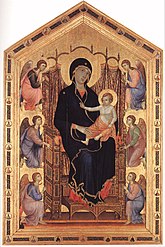
-
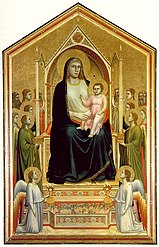
-

-
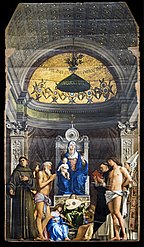
-

-

-
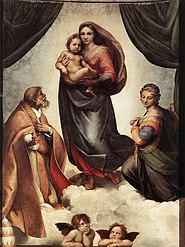
Raphael, The Sistine Madonna, 1513-fourteen.
Fresco cycles [edit]
The largest, near time-consuming paid work that an artist could practise was a scheme of frescoes for a church building, individual palace or commune building. Of these, the largest unified scheme in Italian republic which remains more-or-less intact is that created by a number of dissimilar artists at the cease of the Medieval period at the Basilica of St. Francis of Assisi. It was followed by Giotto's Proto-Renaissance scheme at Padua and many others ranging from Benozzo Gozzoli's Magi Chapel for the Medici to Michelangelo's supreme accomplishment for Pope Julius II at the Sistine Chapel.
- Giotto painted the large, gratis-continuing Scrovegni Chapel in Padua with the Life of the Virgin and the Life of Christ. Breaking from medieval tradition, it prepare a standard of naturalism.
- The two large frescoes of Allegories of Good and Bad Authorities painted by Ambrogio Lorenzetti for the District of Siena are completely secular and evidence detailed views of a townscape with citizens, emphasising the importance of civic order.
- Past dissimilarity, Andrea di Bonaiuto, painting for the Dominicans at the new church of Santa Maria Novella, completed a huge fresco of the Triumph of the Church building, which shows the office of the church in the work of Salvation, and in particular, the part of the Dominicans, who also announced symbolically as the Hounds of Sky, shepherding the people of God. The painting includes a view of Florence Cathedral.
- Masaccio and Masolino collaborated on the Brancacci Chapel fresco cycle which is nearly famous for Masaccio'southward lifelike innovations, Masolino's more elegant style is seen in this townscape which skillfully combines two episodes of the Life of St. Peter.
- Piero della Francesca's fresco bike in the church of San Francesco, Arezzo, closely follows the Legend of the True Cross as written past Jacobus de Voragine in the Golden Fable. The pictures reveal his studies of light and perspective, and the figures have an nigh monolithic solidity.
- Benozzo Gozzoli'south fresco bike for the private chapel of the Medici Palace is a tardily piece of work in the International Gothic style, a fanciful and richly ornamental depiction of the Medici with their entourage as the Three Wise Men.
- The elaborate cycle for the House of Este's Palazzo Schifanoia at Ferrara, executed in part by Francesco del Cossa, was also fanciful in its depictions of Classical deities and Zodial signs which are combined with scenes of the life of the family.
- Mantegna's paintings for the Gonzaga also show family unit life only have a preponderance of highly realistic elements and skillfully utilise the real architecture of the room they decorate, the mantelpiece forming a plinth for the figures and the existent ceiling pendentives being obviously supported on painted pilasters.
- While in the Brancacci Chapel, historians seek to identify the faces of Masaccio, Masolino and perhaps Donatello among the apostles, Domenico Ghirlandaio at the Sassetti Chapel makes no endeavor to disguise his models. Each fresco in this religious cycle has two sets of figures: those who tell the story and those who are witness to it. In this scene of the Birth of the Virgin Mary, a number of the noble women of Florence have come in, as if to congratulate the new female parent.
- The Penalization of the Sons of Korah past Botticelli is one of episodes the Life of Moses series, which, together with The Life of Christ, was commissioned in the 1480s as decoration to the Sistine Chapel. The artists Perugino, Domenico Ghirlandaio and Cosimo Rosselli all worked on the carefully designed and harmonious scheme.
- Michelangelo's painting of the ceiling of the Sistine Chapel, which he executed alone over a period of five years, with narratives from Genesis, prophetic figures and the Ancestors of Christ, was destined to become one of the virtually famous artworks in the globe.
- Simultaneously, Raphael and a number of his administration painted the papal chambers known as Raphael Rooms. In The School of Athens Raphael depicts famous people of his 24-hour interval, including Leonardo, Michelangelo, Bramante and himself, equally philosophers of aboriginal Athens.
Subjects [edit]
Devotional images of the Madonna and Child were produced in very large numbers, often for private clients. Scenes of the Life of Christ, the Life of the Virgin, or Lives of the Saints were likewise made in large numbers for churches, particularly scenes associated with the Nativity and the Passion of Jesus. The Last Supper was commonly depicted in religious refectories.
During the Renaissance an increasing number of patrons had their likeness committed to posterity in paint. For this reason there exists a slap-up number of Renaissance portraits for whom the name of the sitter is unknown. Wealthy private patrons commissioned artworks as decoration for their homes, of increasingly secular subject matter.
Devotional paintings [edit]
The Madonna [edit]
These small intimate pictures, which are now about all in museums, were most often done for private buying, but might occasionally grace a small altar in a chapel.
- The Madonna adoring the Christ Child with two Angels has always been particularly popular on account of the expressive niggling boy angel supporting the Christ Kid. Paintings of Filippo Lippi'due south such equally this were to particularly influence Botticelli.
- Verrocchio separates the Madonna and Christ Kid from the viewer by a stone sill, besides used in many portraits. The rose and the cherries correspond spiritual beloved and sacrificial love.
- Antonello da Messina's Madonna and Kid is superficially very like that of Verrocchio, merely it is much less formal and both the mother and the child appear to exist moving rather than posing for the painter. The foreshortened elbow of the Child every bit he reaches for his mother's chest occurs in Raphael's work and can be seen in a different form in Michelangelo'south Doni Tondo.
- The figures placed at opposing diagonals seen in this early Madonna and Child by Leonardo da Vinci was a compositional theme that was to recur in many of his works and be imitated past his pupils and by Raphael.
- Giovanni Bellini was influenced by Greek Orthodox icons. The gold material in this painting takes the identify of the gilded leaf background. The arrangement is formal, even so the gestures, and in particular the mother's adoring gaze, requite a human warmth to this picture.
- Vittore Carpaccio's Madonna and Child is very unusual in showing the Christ Child as a toddler fully dressed in contemporary clothing. The meticulous detail and domesticity are suggestive of Early Netherlandish painting.
- Michelangelo's Doni Tondo is the largest of these works, merely was a individual commission. The highly unusual composition, the contorted form of the Madonna, the three heads all nearly the top of the painting and the radical foreshortening were all very challenging features, and Agnolo Doni was not sure that he wished to pay for it.
- Raphael has skillfully set up opposing forces into play, and united the Madonna and Child with a loving gaze.
-
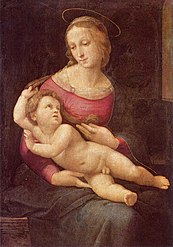
Raphael, The Bridgewater Madonna, 1505.
Secular paintings [edit]
Portraits [edit]
During the latter half of the 15th century, there was a proliferation of portraits. Although the subjects of some of them were subsequently remembered for their achievements or their noble lineage, the identities of many have been lost and that of even the virtually famous portrait of all time, Leonardo da Vinci's Mona Lisa, is open up to speculation and controversy.
- The advantage of a profile portrait such equally Piero della Francesca's Portrait of Sigismondo Pandolfo Malatesta is that it identifies the subject like a facial signature. The proportions of the face, the corresponding angles of the forehead, nose and brow, the position and shape of the center and the set up of the jaw remain recognisable through life. Moreover, once a contour likeness has been taken, information technology tin can be used to cast a medal or sculpt an paradigm in relief.
- Pollaiuolo has conformed to the formula, emphasising this immature adult female's contour with a fine line which also defines the delicate shape of her nostrils and the corners of her oral fissure. But he has added a iii-dimensional quality by the subtle use of chiaroscuro and the treatment of the rich Florentine brocade of her sleeve.
- Alesso Baldovinetti, on the other hand, has used the contour of this strong-featured girl to create a hitting pattern of a highlighted contour against the darker background. The groundwork is a lively shape adding to the compositional structure of the painting. The little black fillet on her brow responds to the dynamic pattern of the embroidered sleeve.
- Botticelli'due south portrait, although turned to three-quarter view with strong tonal modelling, has much to practice with Baldovinetti's painting in its striking organisation of shapes in the red garment, the chapeau and the dark hair and the design that they class against the groundwork.
- Antonello da Messina's portrait, some years earlier than Botticelli's, bears it a passing similarity. Just this painting does not rely heavily on the proficient arrangement of clearly contoured shapes. Antonello has used the advantages of oil paint, as against Botticelli's tempera, to attain a subtle and detailed likeness in which the bushy eyebrows, the imperfections of the skin and the shadow of the beard accept been rendered with photographic precision.
- Ghirlandaio'south tempera portrait of an erstwhile human with his grandson combines the meticulous depiction of the old man's enlarged olfactory organ and parchment-similar skin with a tenderness ordinarily reserved for portrayals of The Madonna and Child. Ghirlandaio takes this illustration further past setting the scene against a window and landscape.
- Pintoricchio's portrait of a boy sets him high in the picture frame, reducing his scale in proportion to the area in contrast to the usual way of showing adults. The painting is set confronting a landscape such as used by Leonardo and Bellini. Pinturicchio's chief fame lay in his skillfully characterised portraits like this.
- In the Mona Lisa Leonardo employed the technique of sfumato, delicately graded chiaroscuro that models the surface contours, while allowing details to disappear in the shadows. The technique gives an air of mystery to this painting which has brought information technology lasting fame. The beautiful hands become almost a decorative element.
- Giovanni Bellini's portrait of Leonardo Loredan, the elected Doge of Venice, has an official air and could inappreciably be more formal. Yet the face is characterised with what ane might promise for in the Doge, wisdom, humour and decisiveness. Although a more elaborate painting, information technology has much in mutual with Baldovinetti's sense of design.
- The subject of Titian's portrait is unknown, and its considerable fame rests solely on its dazzler and unusual composition in which the face is supported and balanced past the large blue sleeve of quilted satin. The sleeve is virtually the same colour as the groundwork; its rich tonality gives it class. The white linen of the shirt enlivens the limerick, while the homo'due south eyes pick up the colour of the sleeve with penetrating luminosity.
- Superficially, Andrea del Sarto'southward portrait has many of the same elements as Titian's. But it is handled very differently, being much broader in treatment, and less compelling in discipline. The painting has accomplished an immediacy, as if the sitter has paused for a moment and is almost to return to what he is doing.
- Raphael, in this much-copied portrait of Pope Julius II, ready a standard for the painting of future popes. Dissimilar the gimmicky portraits hither past Bellini, Titian and del Sarto, Raphael has abandoned the placement of the figure behind a shelf or barrier and has shown the Pope as if seated in his own flat. Confronting the green cloth decorated with the keys of St. Peter, the red velvet papal garments make a rich contrast, the white beard beingness commencement by the pleated white linen. On the uprights of the chair, the acorn finials are the symbol of the Pope's family unit, the della Rovere.
-

-
-

Botticelli, Portrait of Lorenzo di Ser Piero Lorenzi, 1490-1495.
-

-

Titian, The Homo with the blue sleeve, c. 1510.
The nude [edit]
These four famous paintings demonstrate the appearance and acceptance of the nude as a subject for the creative person in its own right.
- In Botticelli'southward Birth of Venus, the nude effigy, although key to the painting, is not of itself the discipline. The bailiwick of the painting is a story from Classical mythology. The fact that the Goddess Venus rose naked from the sea provides justification for the nude study that dominates the heart of the work.
- Painted 30 years after, the exact meaning of Giovanni Bellini's motion picture is unclear. Had the subject been painted by an Impressionist painter, information technology would be quite unnecessary to ascribe a significant. Simply in this Renaissance work, at that place is the presence of a mirror, an object that is usually symbolic and which suggests an allegory. The young lady's nakedness is a sign non then much of seduction, as innocence and vulnerability. Nonetheless, she decks herself out in an extremely rich headdress, stitched with pearls, and having non one, but two mirrors, sees merely herself reflected endlessly. The mirror, often a symbol of prophecy, here becomes an object of vanity, with the young woman in the function of Narcissus.
- Giorgione'due south painting possibly predates Bellini's by ten years. Information technology has always been known equally The Sleeping Venus just there is nothing in the painting to confirm that it is, indeed, Venus. The painting is remarkable for its lack of symbolism and the emphasis on the torso simply as an object of beauty. Information technology is believed to have been completed by Titian.
- Titian's Venus of Urbino, on the other hand, was painted for the pleasance of the Duke of Urbino, and as in Botticelli'due south Birth of Venus, painted for a fellow member of the Medici family, the model looks directly at the viewer. The model may very well have been the mistress of the client. Venus of Urbino is not but a body beautiful in its own right. She is an private and highly seductive young adult female, who is non in the nude land indicative of heavenly perfection, but is only naked, having taken off her clothes but left on some of her jewellery.
Classical mythology [edit]
Paintings of classical mythology were invariably done for the important salons in the houses of individual patrons. Botticelli'due south virtually famous works are for the Medici, Raphael painted Galatea for Agostino Chigi and Bellini'southward Feast of the Gods was, with several works by Titian, in the home of Alfonso I d'Este
- Pollaiuolo's Hercules and the Hydra typifies many paintings of mythological subjects which lent themselves to interpretation that was both Humanist and Christian. In this piece of work good overcomes evil, and courage is glorified. The figure of Hercules has resonances with the Biblical character of Samson who besides was renowned for his strength and slew a king of beasts.
- In Botticelli's Pallas and the Centaur, Wisdom, personified by Athena, leads the cowering Centaur past the forelock, and so learning and refinement are able to overcome animate being instinct, which is the feature symbolised by the centaur.
- Raphael's Galatea, though Classical in origin, has a specifically Christian resonance that would have been recognised by those who were familiar with the story. It is about the nature of love. While all around her aspire to earthly beloved and succumb to the arrows shot by the trio of cupids, Galatea has chosen spiritual beloved and turns her eyes to Heaven.
- Three big works remain that were painted for a single room for the Este past Bellini and his successor Titian. Of these, Titian's Bacchus and Ariadne represents a moment in a narrative. The other two paintings are jolly drinking scenes with a number of narrative elements introduced in a small-scale way, in social club that characters might be identifiable. This painting does not appear to have any higher emblematic sentiment attached to it. It appears to be simply a very naturalistic portrayal of a number of the ancient gods and their associates, eating, drinking and enjoying the party.
-

Botticelli, Pallas Athena and the Centaur, c.1481.
-

Raphael, The Triumph of Galatea, 1511
Come across besides [edit]
- Pseudo-Kufic
- Oriental carpets in Renaissance painting
Sources [edit]
Full general [edit]
- Giorgio Vasari, Lives of the Artists, (1568), 1965 edition, trans George Bull, Penguin, ISBN 0-14-044164-half-dozen
- Frederick Hartt, A History of Italian Renaissance Art, (1970) Thames and Hudson, ISBN 0-500-23136-2
- R.Due east. Wolf and R. Millen, Renaissance and Mannerist Fine art, (1968) Abrams, ISBN unknown
- Keith Chistiansen, Italian Painting, (1992) Hugh Lauter Levin/Macmillan, ISBN 0883639718
- Helen Gardner, Art through the Ages, (1970) Harcourt, Brace and Globe, ISBN 0-xv-503752-8
- Michael Baxandall, Painting and Feel in Fifteenth Century Italy, (1974) Oxford University Press, ISBN 0-19-881329-five
- Margaret Aston, The Fifteenth Century, the Prospect of Europe, (1979) Thames and Hudson, ISBN 0-500-33009-iii
- Ilan Rachum, The Renaissance, an Illustrated Encyclopedia, (1979) Octopus, ISBN 0-7064-0857-viii
- Diana Davies, Harrap'south Illustrated Dictionary of Art and Artists, (1990) Harrap Books, ISBN 0-245-54692-8
- Luciano Berti, Florence: the urban center and its art, (1971) Scala, ISBN unknown
- Luciano Berti, The Ufizzi, (1971) Scala, Florence. ISBN unknown
- Michael Wilson, The National Gallery, London, (1977) Scala, ISBN 0-85097-257-4
- Hugh Ross Williamson, Lorenzo the Magnificent, (1974) Michael Joseph, ISBN 0-7181-1204-0
Painters [edit]
- John White, Duccio, (1979) Thames and Hudson, ISBN 0-500-09135-viii
- Cecilia Jannella, Duccio di Buoninsegna, (1991) Scala/Riverside, ISBN 1-878351-eighteen-iv
- Sarel Eimerl, The Globe of Giotto, (1967) Time/Life, ISBN 0-900658-15-0
- Mgr. Giovanni Foffani, Frescoes by Giusto de' Menabuoi, (1988) Yard. Deganello, ISBN unknown
- Ornella Casazza, Masaccio and the Brancacci Chapel, (1990) Scala/Riverside, ISBN 1-878351-11-7
- Annarita Paolieri, Paolo Uccello, Domenico Veneziano, Andrea del Castagno, (1991) Scala/Riverside, ISBN 1-878351-twenty-vi
- Alessandro Angelini, Piero della Francesca, (1985) Scala/Riverside, ISBN 1-878351-04-iv
- Peter Murray and Pier Luigi Vecchi, Piero della Francesca, (1967) Penguin, ISBN 0-fourteen-008647-1
- Umberto Baldini, Primavera, (1984) Abrams, ISBN 0-8109-2314-9
- Ranieri Varese, Il Palazzo di Schifanoia, (1980) Specimen/Scala, ISBN unknown
- Angela Ottino della Chiesa, Leonardo da Vinci, (1967) Penguin, ISBN 0-14-008649-8
- Jack Wasserman, Leonardo da Vinci, (1975) Abrams, ISBN 0-8109-0262-i
- Massimo Giacometti, The Sistine Chapel, (1986) Harmony Books, ISBN 0-517-56274-X
- Ludwig Goldschieder, Michelangelo, (1962) Phaidon, ISBN unknown
- Gabriel Bartz and Eberhard König, Michelangelo, (1998) Könemann, ISBN 3-8290-0253-Ten
- David Thompson, Raphael, the Life and Legacy, (1983) BBC, ISBN 0-563-20149-five
- Jean-Pierre Cuzin, Raphael, his Life and Works, (1985) Chartwell, ISBN 0-89009-841-7
- Mariolina Olivari, Giovanni Bellini, (1990) Scala. ISBN unknown
- Cecil Gould, Titian, (1969) Hamlyn, ISBN unknown
References [edit]
- ^ John Viii Palaeologus
- ^ Aronberg Lavin, Marilyn (1972). Piero della Francesca: The Flagellation. Chicago, IL: University of Chicago Press. p. 71.
- ^ Nevola, Fabrizio (September 2014). "Architecture in Italian Renaissance Painting: London". The Burlington Mag. 156: 614–15 – via http://world wide web.jstor.org/stable/24241887.
pretzles
Source: https://en.wikipedia.org/wiki/Themes_in_Italian_Renaissance_painting






